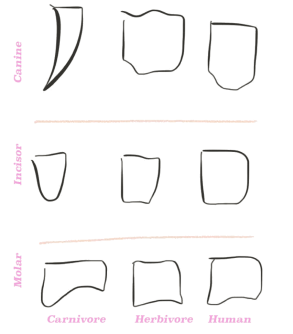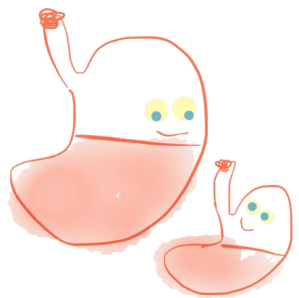 As a child, I loved pretending to be animals. My favourite was cats, and particularly tigers. I even had a cat-tail with a waistband attached and a cat-eared headband that I wore to school for an embarrassingly long period of time. Seriously.
As a child, I loved pretending to be animals. My favourite was cats, and particularly tigers. I even had a cat-tail with a waistband attached and a cat-eared headband that I wore to school for an embarrassingly long period of time. Seriously.
But one day something happened when I looked down at my fingernails: I noticed they weren’t clawed for catching prey like those of the cats I was trying to emulate. And try as I might (and I did) I could not tear chunks of lamb chop off the bone and swallow it whole like I had seen in the documentaries. It didn’t click then, but later the terrible thought came into my head: are humans supposed to eat meat? Time to debunk this vegan myth.
Cue, science!
The Human Diet
Meat is an energy-rich powerhouse full of protein and fat, and our brains being the size they are today is strongly associated with our ancestors enjoying a good steak. By eating more of this energy-rich food and less of lower-energy plant food we could spend less time foraging for plants and more time developing our brains through socialising and developing skills and technology. But many of us now lead comparatively comfortable lives that may no longer require us to eat meat to fuel our further development, and consuming it may even do more harm than good. Therefore, I propose we settle this matter from an objective perspective: anatomy. Yes, let’s use our own bodies for (or against) us!
Despite most of us identifying as omnivores (animals that eat both animal products and plants), renowned physician Dr Milton Mills suggests human anatomy is actually best suited to a herbivorous, or plant-based, diet. This makes sense: we are descended from apes that ate fruits, leaves, tubers, flowers, and other plants. Yet, we can still digest meat. To explore this further, let’s take a closer look at the ways different animals consume food.
Types of consumers
There are three main types of consumers; organisms that eat other organisms for energy. They differ mainly in what they eat and in what amounts, and this causes them to have specific body parts that are designed to break down their food.
| Consumer | Diet | Example |
| Carnivore | Meat only | Lion |
| Omnivore | Meat, plants, and other animal products (e.g. honey) | Bear |
| Herbivore | Plants only | Horse |
Teeth and jaw
 The first step to breaking it down (literally) begins in our mouths and jaws.
The first step to breaking it down (literally) begins in our mouths and jaws.
Shape and size
Here we can see that herbivores and humans share many similarities across their different kinds of teeth – blunted canines and incisors, and cusped molars.
Carnivores, on the other hand, have sharp canines, incisors and molars.
Jaw action
When you eat, do you have to chew your food in order to swallow it? Or can you swallow large chunks? Herbivores (and humans) chew to break down their food which is often tough and fibrous. Carnivores and omnivores shear meat off of bones and swallow it whole, or slightly crush it. It’s a bit like shaving away pieces of wood with a blade to create a carving. Some omnivores also have similar molars for grinding plants.
Stomach and gut
But let’s get down to the guts of it.
pH
Meat-eaters require a low pH level (a highly acidic measurement) stomach acid to break down the harmful bacteria found in the rotting flesh they’ve eaten. Our pH level however is much less acidic than a carnivores or omnivores, and is also most similar to a herbivores.
Size
 Our stomachs are around half the size of a carnivores or omnivores. A large stomach enables these animals to gorge themselves on meat when it is available, as they often only have the opportunity to successfully kill prey once a week (hence, the term ‘wolfing down’ your food). You’ve never known food-comas like these! Herbivores, on the other hand, have a more reliable source of food on which they can graze on and digest constantly throughout the day.
Our stomachs are around half the size of a carnivores or omnivores. A large stomach enables these animals to gorge themselves on meat when it is available, as they often only have the opportunity to successfully kill prey once a week (hence, the term ‘wolfing down’ your food). You’ve never known food-comas like these! Herbivores, on the other hand, have a more reliable source of food on which they can graze on and digest constantly throughout the day.
Length
Our small intestine and colon is long like a herbivores and enables us to break down fibrous foods and absorb all the water from our veges. For a carnivore, they need a shorter gut so that the meat that’s rotting in there is passed through faster.
Salad for one (and all?)
Let me put your mind at ease if you’re feeling a bit upset about having a more similar setup to a rabbit than a tiger.
Anthropologist and human evolution specialist Katharine Milton suggests that our gut can actually alter its size according to changes in diet or energy requirement on a much shorter time scale than previously thought. It has even been found that Egyptians had larger cecums than modern-day humans! But just because we can alter our gut size to enable us to eat meat doesn’t mean we should. Studies have shown no benefit in humans eating excess meat and in fact can cause us a myriad of diseases and illnesses (but more on that later).
So, what now?
Well, as your mum may tell you, ‘all things in moderation’. For myself, if my body is designed to eat plants, then I’m happy to eat just that. In many parts of the world we are privileged enough to have an abundance of delicious plant foods that can more than satisfy our nutritional needs (stay tuned) thanks to horticulture, and I feel my small intestine can remain its normal size because of this, thank you very much.
Peace and science,
Veg-iance.
Header image under licence of Creative Commons.
Other images by Summer Gleeson.
Such a professional layout and love your diagrams!
LikeLike
Great breakdown of the differences between carnivores and herbivores … and where humans sit. Food for thought for sure!
LikeLike
Good job!
LikeLike